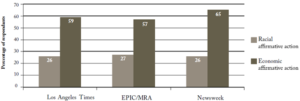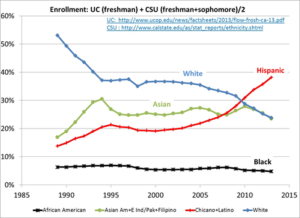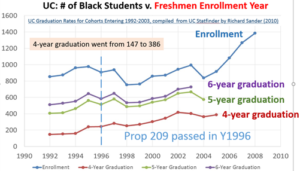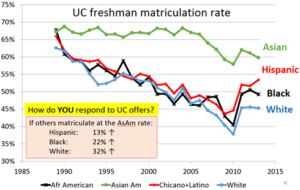Affirmative Action (AA) is a highly-loaded phrase that carries diametrically opposite meaning to different people. No thoughtful debate can be engaged without clearly identify which one of the four common versions is being discussed:
1) The Lyndon Johnson definition vs. the current practice
2) Race-based AA vs. socioeconomic-based AA
The phrase AA was originated in President Kennedy’s Executive Order 10925 in 1961 and in President Johnson’s Executive Order 11246 in 1965 1. The exact original words are: “Take affirmative action to ensure that applicants are employed, and that employees are treated during employment, without regard to their race, color, religion, sex or national origin.” The focus is to stop discrimination using these criteria. The current practice is the exact opposite of the Johnson EO, instead, we must make all decisions based on these considerations. In short, changing “without regard to” into “must consider”. As Chief Justice John Roberts put it succinctly (Parents Involved v. Seattle, 2007): “The way to stop discrimination on the basis of race is to stop discriminating on the basis of race.” Today’s policy practice, especially in education policy such as SCA5 and (perfectly masqueraded) AB1726, is anti-affirmative-action by the Johnson definition.
When Americans are surveyed on whether they support Affirmative Action, the answers depend on how it is phrased. According to the three separate pollings by LA Times/EPIC-MRA/Newsweek, when asked about “race-based” AA, only 26% of the general population supports it, when asked about “socioeconomic-based” AA, 60% supports it.
SDAAFE supports Lyndon Johnson AA and oppose the current practice. We support socioeconomic-based AA and oppose race-based AA. Since more blacks and Hispanics are socioeconomically disadvantaged, statistically they will be helped much more by socioeconomic-based AA referenced to the general population percentage, which is totally fine and we would gladly see it happen. There is no need to use race as a surrogate for socioeconomically disadvantaged. If someone wants to help poor people, just help poor people, instead of treating poor people among Asian and white as not worthy of the same help, or worse, to use ambiguously worded AA policy to push for race-based agenda.
Please be aware the name of the game in Affirmative Action debates is “bait and switch”, keeping the definition vague to achieve hidden objectives, such as making everything proportional to the population rather than based on individual qualifications. If you are against AA (even if it is race-based AA), you will be immediately branded as un-compassionate to poor people, unreasonable, reactionary and repugnant. If you are for AA (even if it is for socioeconomic-based AA only), you will be immediately presented as also support race-based AA. “Bait and switch” is such a standard practice that SCA5 author Senate Hernandez openly argued that “The best and the brightest are not getting into colleges”, the poor and the minorities were not helped, there was a “Asian problem” to be resolved, despite the fact that Hispanics students dominated the UC/CSU enrollment in 2013 with 27243 more than white2, despite the fact that 41% of the UC/CSU student are low-income Pell Grant recipients and 42% are first in family to attend college3. He then call it “equal opportunity” by proposing that the “public education” be removed from the CA constitution and “public university system, community college district, school district” be removed from the definition of the “State”, such that the existing non-discrimination clause in the CA constitution, namely, “The State shall not discriminate against, or grant preferential treatment to, any individual or group on the basis of race, sex, color, ethnicity, or national origin”, would no longer apply to college or secondary admissions. One does not need to wonder what he wants to accomplish. There are plenty of bad precedents in California. For example, in the 1990s, San Francisco Unified School District imposed a 45% quota for Asian American students for neighborhood schools and bus any surplus Asian American students to other schools to solve what was termed the “Asian problem” at the time4, until the policy was ruled unconstitutional (Ho v. SF Unified, 1998) with the passing of Prop-209 in 1996. SCA5 seeks to repeal Prop-209 such that admissions practice similar to that of San Francisco Unified School District would be allowed, and expend it to college admission under the pretense of “equality” and “diversity”5-7. So please do not engage in any AA debate unless the forum allows you to distinguish the four versions listed above. Your opinions will be “baited and switched” whether you like it or not.
Proportional representation, a.k.a. “racial balancing”, has been strictly forbidden as a legitimate argument in the US Supreme Court. Many resounding statements have been made in this process. For example: “Racial balancing is not transformed from ‘patently unconstitutional’ into a compelling state interest simply by relabeling it ‘racial diversity’.” (Parents Involved v. Seattle, 2007) “One of the principal reasons race is treated as a forbidden classification is that it demeans the dignity and worth of a person to be judged by ancestry instead of his or her own merit and essential qualities.” (Rice v. Cayetano, 2000) “Preferring members of any group for no reason other than race or ethnic origin is discrimination for its own sake.” (Regents of UC v. Bakka, 1978) “The Equal Protection Clause commands the elimination of racial barriers, not their creation in order to satisfy our theory as to how society ought to be organized.” (DeFunis v. Odegaard, 1974)
Racial preference is divisive and helps the wrong kids. According to 2004 data, 86% of African American students in highly selective colleges are middle or upper class8. Race-based admissions tend to enhance such socioeconomic statistics. In Fisher v. University of Texas at Austin, plaintiffs challenged the use of race in admissions, arguing that Texas’s race-neutral “Top Ten Percent” creates sufficient racial diversity: 4.5 percent African-American and 16.9 percent Hispanic in 2004. Yet the university argued that a “race-based” plan is still needed to bring in affluent minorities to create diversity within diversity, and an incredulous Justice Kennedy retorted “So what you’re saying is that what counts is race above all.” By contrast, here in California where racial consideration in state university admission is banned, California schools must work harder to achieve diversity and instead focus on socioeconomic status, with great level of socioeconomic diversity achieved as cited earlier3.
Racial preference hurts American competitiveness. The US secondary school “pipeline” is lagging behind other countries. In the 2009 global Programme for International Student Assessment (PISA) survey, the US ranked 30th in math and 23rd in science out of 65 countries. Education Secretary Arne Duncan said it was “an absolute wake-up call for America!” In 2012, the US ranked 35th overall in the PISA survey. The same Secretary Duncan argued “We must invest in early education, raise academic standards”. President Barack Obama also recognized that we Americans are not living in a bubble. In his commencement speech to the historically black Morehouse College students on May 19th, 2013, he told the aspiring graduates “…in today’s hyperconnected, hypercompetitive world, with a billion young people from China and India and Brazil entering the global workforce alongside you, nobody is going to give you anything you haven’t earned. And whatever hardships you may experience because of your race, they pale in comparison to the hardships previous generations endured and overcame.” He is correct. With a supportive environment and academic rigor properly matched to academic preparation, historically black colleges and universities are producing 40% of the African American scientists and engineers in this country even though the overall enrollment is only 20% of the college bound African American students5.
Racial preference papers over deep-rooted social problems, condemning under-privileged kids of all races to a permanent cycle of dysfunctional schools and compromise academic missions in the long run. It is not even needed. Locally in San Diego, we have a shining beacon of hope. The Preuss School UCSD used a race-neutral approach to fix the high school pipeline problem. It is a charter school built and run by UCSD with eligibility limited to students of all colors from low income families with non-college parents. The diverse student population include 68% Hispanic, 10% black, 19% Asian, and 3% white. It was ranked the “5th best school in California, and 42nd nationwide by US News $ World Report in 2014, and “top transformative high school in the nation” by Newsweek. Its students achieved an astounding Academic Performance Index (API) of 888, and the seniors are 100% college bound. Thank you UCSD for the inspiring leadership! Why can’t such a successful race-neutral solution be promoted statewide to solve the high school pipeline problem, rather than rigging the UC/CSU college admissions with race-based policy?
Judging people by their skin color is morally repugnant. It is not fair to pass over better qualified students based on innate characteristics, which violates the Equal Protection Clause in the 14th Amendment that “No State shall deny to any person within its jurisdiction the equal protection of the law”. Equal opportunity is referenced to individual merits, it never guarantees equal results. To the contrary, enforcing equal outcome regardless of qualification and effort bears the hallmark of Communism. Racial preferences foster victimhood, removing any incentive to excel. It also stigmatized the “beneficiaries”, degrading the perceived worth of their college degrees in the eyes of others. Even the leading liberal Justice of the 1970s’, Justice William O. Douglas admonished that “All races can compete fairly at all professional levels. So far as race is concerned, any state-sponsored preference to one race over another in that competition is in my view ‘invidious’ and violative of the Equal Protection Clause.” (DeFunis v. Odegaard, 1974)
True diversity is the diversity of ideas, the celebration of our differences; it’s not clumsy attempts to equalize everything. If the United States is a melting pot, why is it necessary to identify each ingredient? If AB1726 was purported to help Asian Americans by subdivision, why not setting the granularity level at that of each individual, so that each deserving individual would be helped regardless of his/her race and ethnicity? Why not subdivide all other races and ethnicities such as Hispanics, African Americans, Jews, Caucasians into many many buckets so that they can also enjoy the special care and attention of the California government? Since when we Asian American becomes the Chosen People? The irony can’t be more emphatic given the ignominious role California politicians and populace played in instigating the Chinese Exclusion Acts of 1882 and the Japanese Internment in 1942?
“I have a dream that my four little children will one day live in a nation where they will not be judged by the color of their skin but by the content of their character.”
I have a dream. Do you?
References:
1. On EO 11246: https://www.dol.gov/ofccp/regs/statutes/eo11246.htm
2. On 27243 more Hispanics enrolled than white in 2013: UC data: 1389 more, http://www.ucop.edu/news/factsheets/2013/flow-frosh-ca-13.pdf , CSU data: 25854 more, http://www.calstate.edu/as/stat_reports/ethnicity.shtml; the data debunk the common myth that minority plummeted and Asian skyrocketed after Prop 209.
The truth is both the minority enrollment and graduation have increased since Prop 209, thanks to a better academically qualified student body with overt racial consideration. Prop 209 caused a reshuffle of student populations among various UC/CSU campuses without major changes in the overall enrollment figure for each racial group across the system. Rather, it better matched each student’s academic preparation to the specific campus he/she is enrolled, leading to dramatic increases in 4-year graduation rates among all racial groups. For example, the traditionally socioeconomically disadvantaged minorities such as Hispanics and African Americans see their 4-year graduation rates more than doubled over a 10-year period. This shall be cause for celebration.
Student enrollment is a complex phenomenon impacted by many factors. On the one hand, UC/CSU requires the completion of A-G courses as a minimum admissions criterion. The poor state of California secondary education system ensured many high school students do not possess such a qualification therefore ineligible. For example, among the 2013 graduates, only 29.1% of all Hispanic 12th grade completed A-G, of those 74.3% were offered admissions. In comparison, 47.1% of white students completed A-G, of those 53.4% were offered admissions. (Source: http://www.sacbee.com/2014/05/04/6374257/viewpoints-uc-should-trumpet-minority.html, California Dept. of Education, Data Reporting Office 03/24/2014,http://dq.cde.ca.gov/dataquest/stgradnum.asp?cChoice=StGrdEth&cYear=2012-13&ProgramName=All&cTopic=Graduates&cLevel=State&myTimeFrame=S)
Where is the purported discrimination that SCA5 sponsors claimed? The “racial preferences” debate on false premise deflects urgent attention to education quality, thereby permanently condemns kids of all races to dysfunctional secondary schools, including 70.9% of Hispanics students. On the other hand, each student makes his/her own decision on whether to attend a school who offered admissions, the collective responses of each racial group is different. If each racial group matriculated at the same rate as Asian Americans, then the Hispanic enrollment will shoot up 13%, African American enrollment will shoot up 22% in the UC system, and the white student enrollment will shoot up 32%. (Source: http://www.ucop.edu/news/factsheets/2013/flow-frosh-ca-13.pdf)
Why did Senator Hernadez blame UC policy bias when culturally more education-centric Asian Americans enthusiastically embrace UC offers at a higher rate?
3. On low income student data: In 2011-12, 41% or 74933 UC students received Pell Grant, majority of which having family income <$50K. In 2007-08, 42% UC students are the first in the family to receive college education, leaving both selective public and private research universities. http://accountability.universityofcalifornia.edu/2013/2.6.1/AF14-2.6.1-UW.png
4.On Ho v. SF School District: http://law.justia.com/cases/federal/district-courts/FSupp/965/1316/2138871/
5.On how affirmative action is practiced in colleges and law schools: “Mismatch: How Affirmative Action Hurts Students It’s Intended to Help, and Why Universities Won’t Admit it”, Prof. Richard Sander, Mr. Stuart Taylor, 2012. https://www.amazon.com/Mismatch-Affirmative-Students-s-Universities/dp/0465029965/ref=sr_1_1?s=books&ie=UTF8&qid=1485130434&sr=1-1&keywords=Mismatch
6. On current UCLA Admission Practice based on six years of admissions statistics: “Cheating: An Insider’s Report on the Use of Race in Admissions at UCLA”, Prof. Tim Groseclose, UCLA, 2014, https://www.amazon.com/Cheating-Insiders-Report-Race-Admissions/dp/1457528290/ref=sr_1_1?s=books&ie=UTF8&qid=1485130174&sr=1-1&keywords=Cheating+UCLA
7. On the history of how “the Jewish Problem” was solved in 1920s and why the phrase “diversity” was introduced in the context of college admission: “The Chosen: The Hidden History of Admission and Exclusion at Harvard, Yale, and Princeton”, Jerome Karabel, 2006, https://www.amazon.com/Chosen-History-Admission-Exclusion-Princeton/dp/061877355X/ref=sr_1_1?s=books&ie=UTF8&qid=1485130330&sr=1-1&keywords=the+chosen+karabel
8. “The Shape of the River”, the race-based affirmative action supporter Bible written by William G. Bowen (Former Princeton President), Derek Bok (Former Harvard President), Glenn C. Loury, https://www.amazon.com/Shape-River-William-G-Bowen/dp/0691050198.





